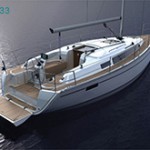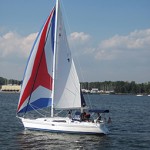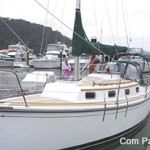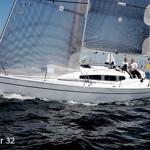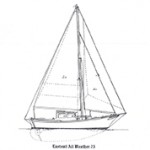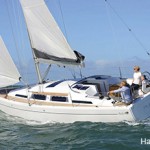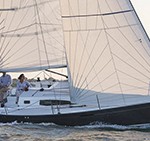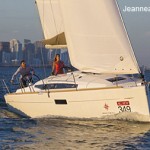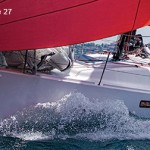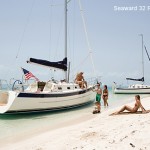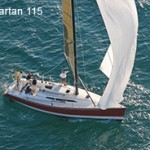![Bavaria_Cruiser_32]() 2011 BOAT SHOW PREVIEW • BAVARIA CRUISER 32 • Last summer, Bavaria USA introduced four new models to the U.S. market. The smallest of the fleet is the Bavaria 32, which packs a lot in a fairly small package. Designed by Farr Yacht Design, who designed all of the new Bavaria models, the 32 has a voluminous hull that makes the interior feel like you are on a 36-footer. But the boat is also very slippery through the water and extremely close-winded for a cruising boat.
2011 BOAT SHOW PREVIEW • BAVARIA CRUISER 32 • Last summer, Bavaria USA introduced four new models to the U.S. market. The smallest of the fleet is the Bavaria 32, which packs a lot in a fairly small package. Designed by Farr Yacht Design, who designed all of the new Bavaria models, the 32 has a voluminous hull that makes the interior feel like you are on a 36-footer. But the boat is also very slippery through the water and extremely close-winded for a cruising boat.
The 32 has an in-mast furling mainsail and a small roller furling jib. The jib is only 108 percent of the fore-triangle and sheets inside the shrouds. With tight sheeting angles, the boat sails to windward like a dream and tacks inside 80 degrees. Off the wind, the 32 is very easily driven and offers excellent speeds when broad reaching.
Down below, the 32 is huge for a boat of this size. The master cabin has a large double berth tucked aft under the cockpit and a smaller double cabin forward for kids or guests. The benches in the saloon can double as berths, too. The galley is aft at the foot of the companionway ladder with the aft-facing chart table next to it. The L-shaped dinette will seat four for dinner.
A great starter cruiser for a young family or a perfect downsize for an older couple who want to simplify their sailing life, the Bavaria Cruiser 32 offers great sailing qualities and a lot of living space below.
Specifications: LOA 32’9”; LWL 29’0”; Beam 11’3”; Draft 4’11”; Displ. 11,464 lbs.; Sail area 549 sq. ft. For more information, call 855-222-1120 or visit www.bavariayachts.com.
![Bavaria_Cruiser_36]() BAVARIA CRUISER 36 • Like its little sister, the Bavaria Cruiser 36 feels much larger than its length might imply. In fact, this boat feels bigger when stepped aboard, when it is hit by a puff of wind, and when you go below into the cabin.
BAVARIA CRUISER 36 • Like its little sister, the Bavaria Cruiser 36 feels much larger than its length might imply. In fact, this boat feels bigger when stepped aboard, when it is hit by a puff of wind, and when you go below into the cabin.
The 36 has the same style rig as the 32, with an in-mast furling mainsail and a small jib that sheets inside the shrouds. Because the headsail is small, the boat is easy for a couple to tack and the sail can often be trimmed without having to grind the sheet winch.
The cockpit has long bench seats and the backs are ergonomically shaped to give lumbar support for comfort. Like all of the Bavaria Cruiser fleet, the 36’s transom folds down to create a large platform aft for sunning, swimming, donning SCUBA gear or climbing into the dinghy.
The 36 comes in either a two-cabin, one-head layout or a three-cabin, one-head plan. The first will probably appeal to couples who sail with friends, while the latter will be a good layout for a family. The boat has only one head, but the compartment is large and has a partition that converts it into a shower.
The interesting thing about the new Bavaria line is that owners have a lot of options when they spec out their new boats. You can choose from three different wood styles, floor patterns and numerous fabrics and colors. Bavaria has the capacity to build 3,000 boats a year, but they build each to its owner’s own personal requirements.
The Cruiser 36 will make a great family cruising boat that is small enough to be affordable but large enough to really be a floating home away from home.
Specifications: LOA 37’1”; LWL 32’5”; Beam 12’0”; Draft 5’4”; Displ. 15,432 lbs.; Sail area 742 sq. ft. For more information, call 855-222-1120 or visit www.bavariayachts.com.
![Bavaria_cruiser_40]() The BAVARIA CRUISER 40 takes the company’s theme of large interiors in boats that sail very well and really puts it to great use. The 40 comes with only one accommodation plan—a three-cabin, two-head layout that emphasizes comfort.
The BAVARIA CRUISER 40 takes the company’s theme of large interiors in boats that sail very well and really puts it to great use. The 40 comes with only one accommodation plan—a three-cabin, two-head layout that emphasizes comfort.
The 40’s rig is proportionally slightly taller and larger than that of the 36 and thus the boat has a bit more sail power. This boat will sail at 8 knots in 12 knots of wind, so you get the idea.
The cockpit is large and laid out for easy sailing and outdoor living. With twin wheels, you always have a good view forward while steering or maneuvering around a marina. Plus, twin wheels open the aft end of the cockpit so you have direct access to the huge aft platform that is formed when the transom is folded down.
The interior has the galley along the port side of the saloon with a dinette that seats six to starboard. There is a good-sized chart table aft of the dinette. With almost seven feet of headroom throughout the interior and plenty of overhead hatches and ports in the cabin sides and hull sides, the interior is flooded with natural light and extremely well-ventilated.
The 40 will be plenty of boat for many couples or families since the sleeping cabins are so large, the heads so roomy, and the dinette and cockpit table well-designed for meals in all weather. Plus, the 40 sails very well indeed.
Specifications: LOA 4’6”; LWL 35’3”; Beam 13’0”; Draft 5’5”; Displacement 19,135 lbs.; Sail area 883 sq. ft. For more information, call 855-222-1120 or visit www.bavariayachts.com.
![Bavaria_Cruiser_45]() Bavaria builds three larger Cruisers—the 45, 50 and 55—but of these, only the CRUISER 45 will be in the U.S. this year.
Bavaria builds three larger Cruisers—the 45, 50 and 55—but of these, only the CRUISER 45 will be in the U.S. this year.
The 45 is a big boat for a 45-footer. In fact the transom and after sections of the hull are so wide that Farr Yacht Designs equipped the boat with twin rudders to go with the twin wheels in the cockpit. This configuration means that one rudder is always in the water and fully functioning even when the boat is heeled over and clawing to windward. Twin rudders also make the 45 sail as if it were on rails, with fingertip control at all times.
The 45 has the same simple and efficient rig as the smaller boats, which drives it well even in light breezes. The cockpit is huge and has a drop-leaf table that will seat eight adults for a meal. The chartplotter can be installed neatly on the after end of the table, so it can be seen from both helms. The transom on the 45 has an electric motor to raise and lower it so you don’t throw out your back hoisting it into place. The platform is large enough for several people to sunbathe.
Down below, the 45 can be arranged with either a three-cabin, three-head plan or a four-cabin, three-head layout. The galley runs along the saloon’s port side and offers an acre of counter space. To starboard, the dinette wraps around a handsome dining table that will also accommodate eight for dinner. The chart table just aft of the dinette faces aft and has a nifty folding seatback that is part of the dinette.
The 45 will be a good family cruiser or will fit very nicely into a charter fleet. The cabins are large and comfortable, the living spaces huge and airy, and the eating arrangements great for crowds. The Cruiser 45 is a true liveaboard yacht.
Specifications: LOA 46’10”; LWL 41’8”; Beam 14’3”; Draft 5’8”; Displ. 27,777 lbs.; Sail area 1,151 sq. ft. For more information, call 855-222-1120 or visit www.bavariayachts.com.
![Beneteau_Oceanis_41]() BENETEAU OCEANIS 41 & 45 • This fall, Beneteau will unveil two new Oceanis models that carry on the Oceanis cruising traditions while incorporating some truly innovative design features to make the boats easier to sail and more comfortable to live aboard. The most notable feature in the new design is the high cockpit arch that anchors the main sheet and provides a rigid frame for a dodger and other cockpit enclosures. Both boats are truly set up for indoor-outdoor living, so the cockpits are huge and access up and down the companionway ladder is excellent.
BENETEAU OCEANIS 41 & 45 • This fall, Beneteau will unveil two new Oceanis models that carry on the Oceanis cruising traditions while incorporating some truly innovative design features to make the boats easier to sail and more comfortable to live aboard. The most notable feature in the new design is the high cockpit arch that anchors the main sheet and provides a rigid frame for a dodger and other cockpit enclosures. Both boats are truly set up for indoor-outdoor living, so the cockpits are huge and access up and down the companionway ladder is excellent.
The cockpits have twin wheels and an innovative folding transom system that fully encloses the cockpit when underway, then folds down electrically to form a swim platform when at anchor. Designed by Finot-Conq, the 41 and 45 have thoroughly modern rigs with the mast set fairly far aft and the headsail reduced to a slightly overlapping jib that sheets inboard of the side stays, which in turn have been moved outboard to the gunnel. With tight sheeting angles, the boats promise to be handy and close-winded while being easy to tack and jibe. For off-the-wind sailing, a reacher or asymmetrical chute will really add fun and power.
The Oceanis 41 has three accommodation plans to choose from. The two-cabin, one-head version offers a good quarter cabin aft and a large V-berth forward; this plan has a huge sail locker and storage area under the port cockpit seat. The three-cabin, one-head plan uses the sail locker space for a second aft cabin. The three-cabin, two-head version tucks a second head into the forward cabin, which replaces the small desk or vanity found in the other accommodation plans. In all three layouts, the after head has a separate shower stall. The saloon remains the same in all three versions, with the L-shaped galley aft to port and the dinette forward to starboard.
![Beneteau_Oceanis_45]() The Oceanis 45 is also offered with three optional accommodation plans. The two-cabin, two-head version has the same large storage area aft as seen in the 41. The three-cabin, two-head plan replaces the storage area aft with a second aft cabin. And, the three-cabin, three-head design equips each of the three cabins with its own en suite head; in this version, the shower stall in the aft head has been replaced with an expanded dinette storage compartment. Both of the new boats are being built in Beneteau’s plant in Marion, South Carolina, so they are truly American boats.
The Oceanis 45 is also offered with three optional accommodation plans. The two-cabin, two-head version has the same large storage area aft as seen in the 41. The three-cabin, two-head plan replaces the storage area aft with a second aft cabin. And, the three-cabin, three-head design equips each of the three cabins with its own en suite head; in this version, the shower stall in the aft head has been replaced with an expanded dinette storage compartment. Both of the new boats are being built in Beneteau’s plant in Marion, South Carolina, so they are truly American boats.
The new designs will be fast, weatherly and very comfortable to live aboard. And they offer the great value that Beneteau is known for worldwide.
Oceanis 41 specifications: LOA 41’9”; LWL 38’1”; Beam 13’9”; Draft 6’9”; Displ. 18,386 lbs. Oceanis 45 specifications: LOA 45’5”; LWL 42’10”; Beam 14’9”; Draft 7’1”; Displ. 21,054 lbs.
For more information, call 843-629-5309 or visit www.beneteauusa.com.
![Hake_46_lineart]() HAKE SEAWARD 46 • An innovative design from Hake Yachts in Florida, the new Seaward 46 is a shoal draft cruiser that is capable of extended offshore sailing. With a ballasted retractable keel and retractable rudders, the 46 can cruise in less than three feet of water. Yet, with the keel and rudders fully deployed, the boat will draw over seven feet and will be a stiff and stable platform for blue water sailing.
HAKE SEAWARD 46 • An innovative design from Hake Yachts in Florida, the new Seaward 46 is a shoal draft cruiser that is capable of extended offshore sailing. With a ballasted retractable keel and retractable rudders, the 46 can cruise in less than three feet of water. Yet, with the keel and rudders fully deployed, the boat will draw over seven feet and will be a stiff and stable platform for blue water sailing.
The big sister to the Seaward 32 and 26, both of which are shoal draft cruisers with retractable keels, the 46 is a raised deck saloon design with a large aft cockpit. The boat can be configured with either a single 75-horsepower diesel or twin 54-horsepower engines. And there is a “fishing” option that fits a fighting chair and rod holders at the stern.
The 46 has a fairly narrow 13-foot beam and a small but handy rig with a 100 percent self-tacking jib, so it should be easily driven even in light airs. The 46 has been in the works for a while and has already stirred up a lot of interest since there are not many retracting keel cruisers on the market, with the exception of Southerly Yachts in England. Look for the boat at the Annapolis Sailboat Show in October. Specifications were not available at press time.
For more information, call 727-287-3200 or visit www.seawardyachts.com.
![Hallberg_Rassy_372]() HALLBERG-RASSY 372 • The new German Frers-designed Hallberg Rassy 372 is another cruiser under 40-feet that will appeal to couples and young families. The 372 replaces the popular HR 37.
HALLBERG-RASSY 372 • The new German Frers-designed Hallberg Rassy 372 is another cruiser under 40-feet that will appeal to couples and young families. The 372 replaces the popular HR 37.
HR has built more than 8,000 cruising boats over the years, so it is well established as one of the world’s cruising yacht leaders. The new 372 is slightly longer, beamier and more streamlined below the water than the 37. The rig is more than a meter taller, and the sail plan has been configured to fly a large mainsail and a small headsail that will be easy to tack and trim. A self-tacking jib option is available. The three-spreader rig can be fine-tuned with the standard backstay adjuster, and the chainplates for the shrouds are far inboard, allowing tight sheeting angles and keeping side decks uncluttered.
The 372 has a clean deck layout. The furling drum for the genoa is mounted below decks, as is the anchor windlass at the bow. Down below, the 372 offers classic HR quality with a U-shaped, seagoing galley, bench settees and storage for gear, groceries and spares. The chart table is across from the galley, while the head and shower are behind it. The forward cabin sports a large double berth, a vanity, hanging and storage lockers, and bookshelves. The after cabin has a huge double berth and additional storage.
The 372 was voted European Boat of the Year in 2010. The new design is a fine example of the great work HR does and just how much you can fit into a sleek and speedy 37-foot hull.
The HR 372 will make a great voyaging boat for a couple who like to sail fast and want to bring their comforts with them to sea.
Specifications: LOA 33’6”; LWL 29’5”; Beam 11’6”; Draft (deep) 5’6”; Displ. 12,400 lbs.; Sail area 625 sq. ft. For more information, contact Eastland Yachts in Essex, CT (860-767-8224), Free State Yachts in Deal, Maryland (410-867-9022), Swiftsure Yachts in Seattle, Washington (206-378-1110), or visit www.hallberg-rassy.com
![Hanse_495]() HANSE 495 • This year, Hanse will introduce several new models, among them the stylish and innovative 495. A powerful modern cruising sloop, the 495 has a Judel-Vrolijk hull with a nearly plumb bow and squared-off transom. The hull’s sheer is fairly straight, so the boat’s profile makes it look purposeful and fast. Think of that long waterline.
HANSE 495 • This year, Hanse will introduce several new models, among them the stylish and innovative 495. A powerful modern cruising sloop, the 495 has a Judel-Vrolijk hull with a nearly plumb bow and squared-off transom. The hull’s sheer is fairly straight, so the boat’s profile makes it look purposeful and fast. Think of that long waterline.
On deck, the broad beam and low cabin house make the boat feel spacious. The cockpit is open aft, so the floor flows between the twin wheel back to the transom. The decks are uncluttered, and because the jib is a self-tacker on its own track, the chainplates and shrouds were moved outboard to allow unimpaired passages along the side decks. With teak decks and recessed hatches, a 495 will have a Wally Boat modern Euro look.
Down below, the 495 offers a large owner’s cabin forward with a centerline double berth and plenty of storage space. The head and shower are in separate compartments port and starboard. In the standard layout, twin quarter cabins aft have good headroom and plenty of lockers. Ventilation is via open deck hatches and ports that open into the cockpit. The aft cabins are served by a single head to port that has a nice big shower stall. The standard saloon plan has the galley along the port side and the large U-shaped dinette to starboard with a bench amidships to seat two more guests. The chart table is just aft of the dinette and close to the companionway. The styling evokes modern European furniture, with contrasting light and dark woods, sharp angles and expanses of open floor.
Hanse offers so many ways to customize your new boat that no two 495s will ever be the same. Fun to sail, comfortable down below, and a truly modern statement in cruising, the Hanse 495 will appeal to those who want the latest thinking and the ability to customize the look of their boat to a great extent.
Specifications: LOA 50’6”; LWL 44’5”; Beam 15’7”; Draft 6’9”; Displ. 30,900 lbs.; Sail area 1,390 sq. ft. For more information, call 978-903-0380 or visit usa.hanseyachts.com or www.hanseyachts.com.
![Moody_45AC]() MOODY 45AC • Hanse Yachts in Germany bought the Moody brand several years ago and came out at once with a truly innovative deck saloon or pilothouse model that turned a lot of heads. Since then, the company has gone back to designer Bill Dixon for a more traditional aft cockpit luxury cruising boat to fit the Moody brand.
MOODY 45AC • Hanse Yachts in Germany bought the Moody brand several years ago and came out at once with a truly innovative deck saloon or pilothouse model that turned a lot of heads. Since then, the company has gone back to designer Bill Dixon for a more traditional aft cockpit luxury cruising boat to fit the Moody brand.
The Aft Cockpit 45 is a modern sloop with a tall fractional rig and a sweet, traditional-looking hull with balanced ends and a springy sheer. The full battened mainsail is standard, but in-boom furling could be added without degrading sailing performance. The jib is self-tacking and runs to a track athwart the forward cabintop, making upwind sailing a snap. The 45’s cockpit has twin wheels, a folding transom and a lovely varnished table with folding leaves. A low windshield wraps around the companionway, keeping spray out of the cockpit and providing a good base for a canvas dodger.
Down below, the furniture is finished in varnished mahogany around accents of white panels and trim, so the whole effect is of traditional Bristol Fashion neatly modernized. Raised panel doors and drawers, some with wicker inserts to enhance ventilation, add a classic touch. The seagoing galley is at the foot of the companionway to starboard, while the head and shower are to port. Aft, the 45 AC has twin quarter cabins while the master cabin is forward with its own en suite head and shower. The dinette amidships is huge, and across from it are two easy chairs on either side of a small table that doubles as the nav station.
Hanse has made a serious effort to offer Moody as a truly upscale brand that will appeal to sailors who want a well designed, fine sailing yacht that is finished to the highest degree. Specifications: LOA 45’0”; LWL 40’1”; Beam 13’8”; Drat 7’3”; Displ. 26,895 lbs. Sail area 1,205 sq. ft. For more information, call 978-903-0380 or visit www.hanseyachts.com.
![IslandPacket_360]() ISLAND PACKET 360 • Island Packet Yachts has been building seaworthy cruising boats for 30 years, and you will find them in the world’s best cruising grounds. With designer Bob Johnson’s Full Foil Keel, moderate sail area-to-displacement ratios, cutter rigs and self-tacking Hoyt Jib Boom Staysails, the line has a well earned reputation for easy motion in a seaway and high average speeds over the long haul. On IPY designs, you arrive at the end of the passage more rested than when you began.
ISLAND PACKET 360 • Island Packet Yachts has been building seaworthy cruising boats for 30 years, and you will find them in the world’s best cruising grounds. With designer Bob Johnson’s Full Foil Keel, moderate sail area-to-displacement ratios, cutter rigs and self-tacking Hoyt Jib Boom Staysails, the line has a well earned reputation for easy motion in a seaway and high average speeds over the long haul. On IPY designs, you arrive at the end of the passage more rested than when you began.
This year, the company is adding to its line a 36-footer that is an evolution of the handsome and sweet sailing Estero.
The 360 is a salty and capable cruiser with a nice springy sheer, a short bowsprit that houses the anchors as well as the roller furling headsail, and a fairly low profile cabin that fits the hull neatly.
The cockpit has been designed for comfort and safety, so it is not overly large and will drain quickly if ever a wave came aboard at sea. All sailing sheets, halyards and control lines run aft, so you never have to leave the cockpit to add or reduce working sail.
The accommodation plan below offers a large double cabin aft with a neat V-style berth that allows you to swing your legs easily to the floor when getting up. This is a pleasant quarter cabin with ample ventilation, a hanging locker and plenty of space for clothes. The forward cabin has a traditional V-berth, hanging and storage lockers, and a private door to the large head. The saloon has the huge galley aft to starboard and an aft-facing chart table. The L-shaped dinette to port will seat four at the fold-down saloon table. Across to starboard, two swiveling easy chairs will make lounging, reading and watching TV just as comfortable as at home.
A great mid-size cruiser, the new IP 360 is a go-anywhere blue water yacht that will look after her crew as a proper yacht should.
Specifications: LOA 36’5”; LWL 31’6”; Beam 12’4”; Draft 4’0”; Displ. 19,300 lbs.; Sail area 831 sq. ft. For more information, call 888-724-5479 or visit www.ipy.com
![Hunter_33]() HUNTER e33 • Hunter has long been a leader in offering sailors a wide range of boats, from sailing dinghies to 50-foot ocean cruisers. But the company may be best known for its mid-size cruisers, which offer expansive living spaces in boats that are easy to sail and handle.
HUNTER e33 • Hunter has long been a leader in offering sailors a wide range of boats, from sailing dinghies to 50-foot ocean cruisers. But the company may be best known for its mid-size cruisers, which offer expansive living spaces in boats that are easy to sail and handle.
The new e33 fits right into that mid-size segment and introduces an attractive new look for the Florida-based builder. With a sleek deck design and large cabin windows, the boat looks modern and fast. The hull has a wider transom than the earlier 33-footer and the bow has been given a narrower entry. The cockpit is large and comfortable for a boat of this size and has a neat fold-down transom that becomes a large swim platform. Hunter uses unique B&R rigs, with sharply swept back spreaders and no backstay. The main is quite large, while the headsail is small enough to be easy to tack. This rig is simple for a couple or even a singlehander to manage.
Over the last decade, Hunter has steadily refined their interior arrangements and the fit and finish of the joinery down below. The e33 has a large athwartships double berth in the after cabin that is tucked in under the cockpit and side deck on the starboard side. The forward cabin has a V-berth and plenty of storage for clothes, linens and towels. The galley has Corian counters, a large fridge and a two-burner stove with an oven below. The dinette to port will seat four easily. To starboard, the bench settee with be a good berth, or the middle section of the bench can be converted quickly to form a chart table. All of the boat’s instruments are accessible from the starboard settee.
A handsome addition to the Hunter line of sailboats, the new e33 offers a lot of accommodations in a cruising boat that will be easy to sail and comfortable for extended cruises.
Specifications: LOA 33’6”; LWL 29’5”; Beam 11’6”; Draft 4’6”/5’6”; Displ. 12,400 lbs.; Sail area 625 sq. ft. For more information, visit www.huntermarine.com.
![Jeanneau_379]() JEANNEAU 379 • The success of the Jeanneau Sun Odyssey 409 that was introduced at last year’s Annapolis show, with its hard chine aft, fold-down stern platform and simple but powerful sloop rig, primed the market for more Jeanneaus of the same style. So this year, Jeanneau is launching the Sun Odyssey 379 and Sun Odyssey 439.
JEANNEAU 379 • The success of the Jeanneau Sun Odyssey 409 that was introduced at last year’s Annapolis show, with its hard chine aft, fold-down stern platform and simple but powerful sloop rig, primed the market for more Jeanneaus of the same style. So this year, Jeanneau is launching the Sun Odyssey 379 and Sun Odyssey 439.
The 379 has a modern hull style with a nearly plumb bow, a squared-off transom and a low slung coach roof. The sloop rig has been set up for ease of handling and good performance. The mainsail is a slab reefed full batten main with lazy jacks. The mainsheets run aft on both sides of the coach roof to the cockpit winches, so the helmsman can trim while steering. The cockpit has been laid out for efficient sail trim. With twin wheels, access to the fold-down swim platform is excellent.
Below decks, the 379 comes in a two- or three-cabin version, both with a large head and separate shower stall. In the two-cabin version, the port quarter becomes a huge sail and storage locker and a small wet locker adjoins the head. In the three-cabin version, the port quarter becomes a sleeping cabin and the head is moved forward. The L-shaped galley is useful, and the dinette forward seats six with the drop leaf raised.
Specifications: LOA 37’0”; Beam 12’0”; Draft 5’0”; Displ. 14,740 lbs.; Sail area 753 sq. ft.
![Jeanneau_439]() The new JEANNEAU 439 has a larger, beamier Philippe Briand hull that will translate into greater cabin volume and stability. The bow sections have a bit more hollow for a narrow entry, which will improve the boat’s motion and windward ability.
The new JEANNEAU 439 has a larger, beamier Philippe Briand hull that will translate into greater cabin volume and stability. The bow sections have a bit more hollow for a narrow entry, which will improve the boat’s motion and windward ability.
Like its little sisters, the 439 is all about good sailing aboard a comfortable boat.
Twin wheels give the helmsman great visibility forward and open the cockpit to the large swim platform.
Down below, the 439 makes use of the extra beam to offer an unusual four-cabin, two-head layout with two double quarter cabins, a V-berth cabin forward, and an upper and lower cabin forward of the main bulkhead. In the three-cabin, two-head version, the forward cabin gets a large centerline double berth and a large vanity or desk. The saloon has the seagoing galley aft and to starboard, where it is convenient to the cockpit and large dinette.
The fit and finish of the 379 and 438 is bright and airy, and multiple hatches and ports provide natural light and excellent ventilation.
Specifications: LOA 44’0”; Beam 14’0”; Draft 7’0”; Displ. 21,736 lbs.; Sail area 1,004 sq. ft.
![boat-44DS_exterieur_20110705145402]() The 44 DECK SALOON (DS) Sun Odysseys are all about elegance, style and comfort. From the swim platform aft to the bow rollers forward, the 44DS embodies the latest in Euro styling. The Philippe Briand designed hull is similar to the 439, but there the similarity ends.
The 44 DECK SALOON (DS) Sun Odysseys are all about elegance, style and comfort. From the swim platform aft to the bow rollers forward, the 44DS embodies the latest in Euro styling. The Philippe Briand designed hull is similar to the 439, but there the similarity ends.
The deck saloon cabintop has a kind of Audi TT curve that flows for the full length of the cockpit and cabintop to the foredeck. The huge side windows are tinted black and set off by dark gray moldings that run along the edge of the cabin. The halyards, sheets and control lines from the mast run in conduits on the cabintop, and the two-ended mainsheet runs under the deck to winches aft by the twin wheels.
The 44DS has a huge aft cabin, with a queen-size double berth under the cockpit and bridgedecks. For added headroom, cockpit soles have been raised and a wide bridgedeck added. The cockpit has a large table with drop leaves and a built-in chart plotter. Down below, the furniture is more angular and the cabinets are lower with an “interior designer” feel, which is not surprising since the styling was done by Franck Darnet. The use of bright white and contrasting black counter and tabletops sets off the wood veneers, cabinets and bulkheads, and the sharp stainless steel latches and fittings are a statement in elegance.
Aside from the full width after stateroom, the 44DS has two guest cabins forward and a second head. One of the cabins has a V-berth, while the others have an upper and lower single berth. The saloon is a trendy modern living space with a large galley, U-shaped dinette and bench settee.
The 44DS will make a fine cruising boat for a couple or family who wants their leisure time to be as elegant and modern as can be.
Specifications: LOA 44’0”; Beam 14’0”; Draft 7’0”; Displ. 21,450 gals.; Sail area 835 sq. ft. For more information, call 410-280-9400 or visit www.jeanneau.com.
![Oyster_625_docked]() The new OYSTER 625, which has been nominated for 2012 Boat of the Year in Europe, is a Rob Humphries design that dramatically upgrades the already popular previous boats in the Oyster line, the 61 and 62.
The new OYSTER 625, which has been nominated for 2012 Boat of the Year in Europe, is a Rob Humphries design that dramatically upgrades the already popular previous boats in the Oyster line, the 61 and 62.
A center cockpit desk saloon design, the 625 has a modern sheer line capped by the new style of wraparound deck saloon windows that Oyster has used so successfully in recent models. The standard rig will have an in-mast furling mainsail and a cutter rig forward. This gives you a lot of trim choices and allows you to shorten sail in rising weather without leaving the cockpit. A Solent headsail rig and in-boom mainsail furling are options.
Down below, the 625 offers a true master stateroom aft with a queen-size double and plenty of storage and comfortable amenities. An owner and spouse will really feel at home here. Forward, two guest cabins are shown in the standard accommodation plan—a Pullman double cabin to starboard and an upper and lower cabin to port. The forepeak has been reserved for a single crewmember, with access to one of the en suite heads that adjoin the forward cabins. The saloon is spacious and will be full of light. The dinette is huge and will seat eight. The galley is in the passageway aft to port and will be an excellent seagoing galley. The chart table at the base of the companionway is a proper navigation command central where you can mount all of your radios, sat phone, chartplotters and radar. Plus, the table is large enough to spread out an old paper chart.
The new Oyster 625 is a handsome, high quality ocean sailing yacht that will keep you safe at sea, get you home quickly, and provide you with elegance and comfort along the way.
Specifications: LOA 63’7”; LWL 56’7”; Beam 17’10”; Draft 9’2”; Displ. 73,854 lbs.; Sail area 2,538 sq. ft. For more information, call 401-846-7400 or visit www.oystermarine.com.
![Sabre_456]() The SABRE 456 was launched late last year and has drawn a lot of attention from both Sabre owners and would-be Sabre owners.
The SABRE 456 was launched late last year and has drawn a lot of attention from both Sabre owners and would-be Sabre owners.
The Jim Taylor design is an upgrade of the Sabre 452 that was introduced several years ago with a new keel, new rig and modernized interior.
On deck, the 456 has a large, secure cockpit with high seatbacks and a single large destroyer wheel. The main sheet runs to the traveler forward of the dodger so the cockpit is not cluttered. The chainplates for the shrouds are well inboard for close sheeting angles on the genoa and to make going forward easier.
Down below, the forward cabin offers a large centerline double berth and a large en suite head with a separate shower stall. The guest cabin aft has a large double berth and plenty of storage space. The 456’s galley is one of the largest and best laid out in any boat of this size. Since you tend to live in the kitchen, the saloon has the feel of a large, homey country kitchen. The drawer-style pull-out fridge is an innovation that we feel sure will catch on in other designs. Sabre has revamped their interior joinery style with a slightly Japanese flair to the doors and cabinets, making great use of the spaces available and adding light to the cabins. Because the 456 is built to order, Sabre can really work with an owner to customize the boat to his or her needs.
A fine offshore quality boat built in “Maine style,” the 456 will carry you across oceans or the bay swiftly and comfortably.
Specifications: LOA 45’6”; LWL 38’4”; Beam 14’1”; Draft 5’6”; Displ. 27,150 lbs.; Sail area 1,043 sq. ft. For more information, call 207-655-3831 or visit www.sabreyachts.com.
![Tartan_4000]() The new Tim Jackett-designed TARTAN 4000, which was introduced last winter, embodies a lot of the new thinking that has gone into the boats and the company since it was purchased by Steve Malbasa last year. The new company is all about delighting customers with great boats and great service.
The new Tim Jackett-designed TARTAN 4000, which was introduced last winter, embodies a lot of the new thinking that has gone into the boats and the company since it was purchased by Steve Malbasa last year. The new company is all about delighting customers with great boats and great service.
The 4000 really speaks to that mission. The cockpit is large and secure, with twin wheels for easy access to the fold-down stern platform. The seats are contoured for optimum comfort around the stowable cockpit table or when sailing hard. Tartan used their patented Cruise Control Rig, which uses a fully battened mainsail with a double headsail rig that deploys an inner upwind jib and a larger reacher on the outer roller. The CCR offers the best in both upwind and downwind sailing without forcing you to fly a spinnaker or even leave the cockpit.
Tartan is unique in the market by offering carbon spars, booms and rudders as standard equipment. Equally unique are the epoxy-infused hull and decks that are tougher, lighter and virtually impervious to osmosis. Down below, the cherry interior has a large centerline double berth and en suite head in the forward cabin. The sofa-style saloon with a fold-down table will be comfortable for up to eight. The galley offers lots of counter space, a large fridge and double stainless steel sinks. Across from the galley, the chart table is a traditional nav station where the skipper or navigator will be in command of all of the ship’s systems.
A fine new entry to the 40-foot cruising fleet, the new Tartan 4000 will be a great couple’s boat and is built to be a family heirloom, albeit one that you could sail across the ocean.
Specifications: LOA 40’ 8”; LWL 36’4”; Beam 13’0”; Draft 7’6”; Displ. 20,104 lbs.; Sail area 893 sq. ft. For more information, call 440-357-7777 or visit www.tartanyachts.com.
![Tartan_4700]() A semi-custom design that was spawned last year and launched late last spring, the new TARTAN 4700 expands upon themes introduced in the 4400 a few years ago.
A semi-custom design that was spawned last year and launched late last spring, the new TARTAN 4700 expands upon themes introduced in the 4400 a few years ago.
On deck, the cockpit is huge and deep and will be very secure at sea. With twin wheels and a folding transom, the living space will feel vast while at anchor and with the platform lowered.
At sea, all buttoned up, you won’t mind running down the face of ocean rollers. The 4700 has Tartan’s Cruise Control Rig, so it is easy and efficient to sail upwind or off the wind and actually sails higher and faster than the 4400. The extra three feet add to the boat’s balance and waterline length, which translates into better performance all around.
Down below, a lot of attention has been given to making the boat a comfortable family home with good communal and private spaces. The large aft cabin is tucked under the cockpit, and the bridgedeck has been raised to provide full headroom across the cabin. The large aft head is next to it to starboard.
The 4700, like the 4400, has a raised dinette that offers good views through the deck saloon windows. And the chart table is raised as well, so you can easily stand watches inside the cabin with great visibility forward and to both sides. The engine room is beneath the raised saloon floor, where you have great access to the engineering systems. Forward, there is a large master cabin with an attached head and a third cabin with upper and lower bunks, which will appeal to children and their friends.
A fine new model in the Tartan line, the 4700 is a liveaboard, offshore quality yacht that offers all of the attributes of Tartans—epoxy hull and deck, carbon rig, carbon rudder, Beavertail shoal draft keel—in an exciting new package. Look for BWS’s full review and the new boat’s specifications in the October issue.
For more information, call 440-357-7777 or visit www.tartanyachts.com.
 TARTAN 4400 • BWS’s 250-mile sea trial of the new Tartan 4400 proves that the boat is an elegant new player in the world of liveaboard cruisers
TARTAN 4400 • BWS’s 250-mile sea trial of the new Tartan 4400 proves that the boat is an elegant new player in the world of liveaboard cruisers The large U-shaped galley has plenty of counter space over the huge refrigerator compartment
The large U-shaped galley has plenty of counter space over the huge refrigerator compartment 
 TARTAN 34 •
TARTAN 34 •
 TARTAN 3400 • The new Tartan 3400 combines high-tech construction and modern design with classic Tartan styling
TARTAN 3400 • The new Tartan 3400 combines high-tech construction and modern design with classic Tartan styling The guest cabin forward has a V-berth that is small by most standards, due in part to the fineness of the bow. The V-berth is a true double berth but two tall people will find themselves locking toes in the night, which might be a good thing. The forward cabin has a lot of storage and hanging space.
The guest cabin forward has a V-berth that is small by most standards, due in part to the fineness of the bow. The V-berth is a true double berth but two tall people will find themselves locking toes in the night, which might be a good thing. The forward cabin has a lot of storage and hanging space. BWS THOUGHTS
BWS THOUGHTS
 TARTAN 4300 • In the August issue of BWS, we ran a full design review of the new soon-to-be launched Tartan 4300. Hull number one is due to premiere at the Newport (R.I.) boat show in September.
TARTAN 4300 • In the August issue of BWS, we ran a full design review of the new soon-to-be launched Tartan 4300. Hull number one is due to premiere at the Newport (R.I.) boat show in September. TARTAN 4300 • Designed for fast, shorthanded cruising, the new Tartan 4300 offers an epoxy hull, carbon fiber spars and the quality to last a lifetime.
TARTAN 4300 • Designed for fast, shorthanded cruising, the new Tartan 4300 offers an epoxy hull, carbon fiber spars and the quality to last a lifetime.




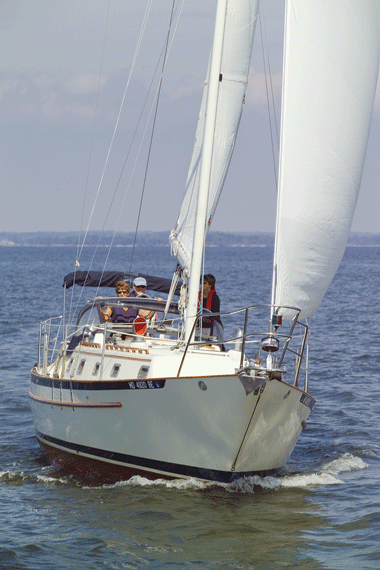 THIN WATER CRUISING BOATS •
THIN WATER CRUISING BOATS • 







 TARTAN 400 •
TARTAN 400 •  THE DESIGNThe new 400 is a masthead sloop with a Solent-style, double headsail rig that couples a self-tacking working jib with a roller furling reacher up front. Sailing to windward, the rig is self-tending through the tacks; off the wind, you roll up the jib and roll out as much reacher as you need. Dead downwind, you can either pole out the reacher or set a spinnaker. The slab-reefed mainsail is controlled with lazy jacks and rests when furled in an innovative pocket boom. This is a simple, efficient and easy rig to manage.The hull and deck designs have a classic Tartan look—not too racy, but hardly dowdy. The bow has a slight overhang and the stern rakes forward in harmony with the bow and sheer. The cabin top sits up above the deck line so the side ports are exposed to light and breeze; and, having the cabin top at this height means you can reach the handrails on it without doubling over or brace a knee when working with both hands.Under the water, the 400 can be had with three keel configurations. The deep seven-foot, six-inch fin version will be the racer-cruiser’s choice if the depth of local waters permits deep draft; the Tartan Beavertail winged keel at five-foot, 10-inch draft will be the most popular compromise keel for all around performance; and, the keel-centerboard option will appeal to gunkholers who habitually cruise in regions with extra thin water such as the Chesapeake Bay, Bahamas and Southern New England. All of the versions have high aspect, balanced spade rudders that are operated by twin wheels in the cockpit.Looking at the hull lines, the 400 has a moderate displacement hull shape with fairly narrow sections, a generous beam of 13 feet, and broad, powerful stern sections that will help the boat stand up to strong reaching breezes (and add volume to the interior for living and storage spaces).The deck layout follows the modern theme of a large, open cockpit with two wheels, a centerline table and a passage aft to the swim platform. The 400 was not given a sugar scoop stern, but instead has a neat folding aft platform that tucks away when under sail. The cockpit will seat six for a meal and can accommodate twice that many for sundowners. The mainsheet traveler has been positioned forward of the companionway, where it is out of the way of the crew but can be adjusted with control lines that lead aft on the cabin top. The mainsheet is shown leading forward to the boom vang and then down to a turning block and aft to a winch on the cabin top next to the companionway. A canvas dodger attaches to the cabin top aft of the main traveler and will provide protection for the crew in wet weather.The bow is equipped with double anchor rollers, so you will be able to easily deploy a second hook whenever the wind picks up during the night. The anchor locker and windlass will handle an all-chain rode plus a second chain-to-rope rode. The second anchor can be stowed in the locker as well.An evolutionary design, the 400 has a lot of qualities that have emerged in the modern Tartan line over the last few years that make it modern but not trendy and certain to be relevant for many years ahead—just like the Tartan 40 or 37.
THE DESIGNThe new 400 is a masthead sloop with a Solent-style, double headsail rig that couples a self-tacking working jib with a roller furling reacher up front. Sailing to windward, the rig is self-tending through the tacks; off the wind, you roll up the jib and roll out as much reacher as you need. Dead downwind, you can either pole out the reacher or set a spinnaker. The slab-reefed mainsail is controlled with lazy jacks and rests when furled in an innovative pocket boom. This is a simple, efficient and easy rig to manage.The hull and deck designs have a classic Tartan look—not too racy, but hardly dowdy. The bow has a slight overhang and the stern rakes forward in harmony with the bow and sheer. The cabin top sits up above the deck line so the side ports are exposed to light and breeze; and, having the cabin top at this height means you can reach the handrails on it without doubling over or brace a knee when working with both hands.Under the water, the 400 can be had with three keel configurations. The deep seven-foot, six-inch fin version will be the racer-cruiser’s choice if the depth of local waters permits deep draft; the Tartan Beavertail winged keel at five-foot, 10-inch draft will be the most popular compromise keel for all around performance; and, the keel-centerboard option will appeal to gunkholers who habitually cruise in regions with extra thin water such as the Chesapeake Bay, Bahamas and Southern New England. All of the versions have high aspect, balanced spade rudders that are operated by twin wheels in the cockpit.Looking at the hull lines, the 400 has a moderate displacement hull shape with fairly narrow sections, a generous beam of 13 feet, and broad, powerful stern sections that will help the boat stand up to strong reaching breezes (and add volume to the interior for living and storage spaces).The deck layout follows the modern theme of a large, open cockpit with two wheels, a centerline table and a passage aft to the swim platform. The 400 was not given a sugar scoop stern, but instead has a neat folding aft platform that tucks away when under sail. The cockpit will seat six for a meal and can accommodate twice that many for sundowners. The mainsheet traveler has been positioned forward of the companionway, where it is out of the way of the crew but can be adjusted with control lines that lead aft on the cabin top. The mainsheet is shown leading forward to the boom vang and then down to a turning block and aft to a winch on the cabin top next to the companionway. A canvas dodger attaches to the cabin top aft of the main traveler and will provide protection for the crew in wet weather.The bow is equipped with double anchor rollers, so you will be able to easily deploy a second hook whenever the wind picks up during the night. The anchor locker and windlass will handle an all-chain rode plus a second chain-to-rope rode. The second anchor can be stowed in the locker as well.An evolutionary design, the 400 has a lot of qualities that have emerged in the modern Tartan line over the last few years that make it modern but not trendy and certain to be relevant for many years ahead—just like the Tartan 40 or 37. LIVING SPACESThe 400 has been created for couples who will often be cruising with other couples and occasionally entering point-to-point events with a larger crew. The boat has two good double cabins and a single large head with a separate shower stall.The master cabin forward has a center-line double that can be accessed from the sides so you don’t have to climb over your partner to slip out during the night. The plan shows two hanging lockers, a small bench sofa, and lockers and shelf space for clothing and personals.The after cabin has a double berth that you climb in from the forward end. There is a hanging locker and built-in cabinets for storage. The cabin has full headroom and ventilation from port holes that vent to the cockpit. This quarter cabin will be the best sea berth on the boat.For additional guests and crew, the bench seats in the saloon can be rigged as single berths; if you add lee cloths, both will make good sea berths when making offshore runs. The starboard bench is six feet long, but the forward backrest cushion can be removed to open up another 13 inches of length for taller crew. Since you rarely sleep forward of the mast at sea, the 400 has three good sea berths that will accommodate a crew of six on passage.The saloon has a modern, open layout. The G-shaped galley to port has a large fridge aft that is both top and front loading, a three-burner Force 10 stove and twin stainless steel sinks that are not far off the centerline so they will drain on both tacks. The galley is near the companionway and has an opening hatch and nearby opening ports so it will ventilate well. Cabinets are built in above the counters aft and outboard and below the sinks and counters.Across from the galley in its traditional position, Jackett has drawn in a proper forward-facing chart table with a table big enough for a paper chart, a seat wide enough for two and instrument cabinets that face aft so all the digital information you need is right in front of you. The electrical panel is outboard of the chart table, so all of the on-off lights are visible throughout the saloon. The 400 comes standard with a 12-volt and an inverter charger for 110-volt appliances. These controls are also in plain view.It is sensible to have only one head on a 40-foot boat. The trend these days is to build in en suite heads with each sleeping cabin, which is fine on charter boats, but wastes a lot of interior space aboard a cruising boat. The 400’s head has entry doors from the saloon and the forward cabin so the sink and vanity are quite small. But, the shower is huge, so you can save water by showering with a friend or swing a loofah around with abandon while singing shanties.The interior of the 400 is in varnished, hand-rubbed cherry and white laminates. Because of the many side ports and the six large deck hatches, the cabin will be woody, but bright and warm. The floors are traditional teak and holly. The recent Tartans all have the feel of finely finished custom furniture.Inside the confines of 40 feet overall and 13 feet of beam, Jackett has laid out living spaces that will stylishly suit a couple’s sailing lifestyle while providing all the room they need for guests and crew sailing offshore.THE BOATThe modern Tartans are different from almost all other production boats, and that difference lies in two words: epoxy and carbon. The boats are not the classic plastics of the past; they are built in the space age with space-age materials.The hulls are all epoxy and glass-fiber laminates with inert foam cores that are molded in one piece using the vacuum-infusion method. The result is the strongest, most durable hull possible.A normal fiberglass hull assembled with polyester and vinylester resins in a hand lay-up process will be 25% glass and 75% resin; the Tartan epoxy infusion systems creates hulls that are 65% glass and 35% epoxy resin. The result of using this method is a much higher strength to weight ratio than is possible with traditional lay-ups. Also, epoxy does not blister or become porous over time.While the hulls and decks are molded in epoxy and fiber glass, the masts and booms are molded from carbon fibers fused with epoxy. The masts are lighter and more durable than aluminum spars, while the new pocket booms Jackett designed are both much easier to use than oval booms and much lighter.By applying the latest in composite and custom building technologies to the production boat building process, Tartan (and C&C) has really advanced the ball for owners who value the performance, safety, longevity, and durability of epoxy hulls and carbon rigs.BWS THOUGHTSThe new Tartan 400 is a very appealing boat for cruisers looking for a practical, innovative boat for coastal and offshore cruising. The design is modern and promises to be fast. The boat is built with the latest materials and techniques. The rig is innovative and very practical for a couple or a singlehander—or for a racing crew headed offshore. And the layout and interior spaces are both elegant and well thought out for extended cruising. Tartan is a venerable American brand, so it is gratifying to see the company launch into the new economic age with a cruising boat that will be a signature of these less rambunctious times. When the new boat is launched this summer, BWS will put it through its paces offshore.Tartan 400LOA 40’7”LWL 36’4”Beam 13’0”Draft (fin) 7’5”Draft (wing) 5’10”Draft (k/cb) 4’8” (up)Displ. (stnd.) 20,104 lbs.Ballast (stnd.) 8,000 lbs.Sail Area (100%) 893 sq. ft.Sail Area (reacher) 814 sq. ft.Fuel 50 gals.Water 100 gals.Engine 55-hp. DieselBridge Clearance 64’1”SA/D 20.5D/L 172B/D 38%Designer Tim JackettTartan Yachts1920 S.R 535Painesville, OH 44077Ph: 440-354-6162www.Tartanyachts.com
LIVING SPACESThe 400 has been created for couples who will often be cruising with other couples and occasionally entering point-to-point events with a larger crew. The boat has two good double cabins and a single large head with a separate shower stall.The master cabin forward has a center-line double that can be accessed from the sides so you don’t have to climb over your partner to slip out during the night. The plan shows two hanging lockers, a small bench sofa, and lockers and shelf space for clothing and personals.The after cabin has a double berth that you climb in from the forward end. There is a hanging locker and built-in cabinets for storage. The cabin has full headroom and ventilation from port holes that vent to the cockpit. This quarter cabin will be the best sea berth on the boat.For additional guests and crew, the bench seats in the saloon can be rigged as single berths; if you add lee cloths, both will make good sea berths when making offshore runs. The starboard bench is six feet long, but the forward backrest cushion can be removed to open up another 13 inches of length for taller crew. Since you rarely sleep forward of the mast at sea, the 400 has three good sea berths that will accommodate a crew of six on passage.The saloon has a modern, open layout. The G-shaped galley to port has a large fridge aft that is both top and front loading, a three-burner Force 10 stove and twin stainless steel sinks that are not far off the centerline so they will drain on both tacks. The galley is near the companionway and has an opening hatch and nearby opening ports so it will ventilate well. Cabinets are built in above the counters aft and outboard and below the sinks and counters.Across from the galley in its traditional position, Jackett has drawn in a proper forward-facing chart table with a table big enough for a paper chart, a seat wide enough for two and instrument cabinets that face aft so all the digital information you need is right in front of you. The electrical panel is outboard of the chart table, so all of the on-off lights are visible throughout the saloon. The 400 comes standard with a 12-volt and an inverter charger for 110-volt appliances. These controls are also in plain view.It is sensible to have only one head on a 40-foot boat. The trend these days is to build in en suite heads with each sleeping cabin, which is fine on charter boats, but wastes a lot of interior space aboard a cruising boat. The 400’s head has entry doors from the saloon and the forward cabin so the sink and vanity are quite small. But, the shower is huge, so you can save water by showering with a friend or swing a loofah around with abandon while singing shanties.The interior of the 400 is in varnished, hand-rubbed cherry and white laminates. Because of the many side ports and the six large deck hatches, the cabin will be woody, but bright and warm. The floors are traditional teak and holly. The recent Tartans all have the feel of finely finished custom furniture.Inside the confines of 40 feet overall and 13 feet of beam, Jackett has laid out living spaces that will stylishly suit a couple’s sailing lifestyle while providing all the room they need for guests and crew sailing offshore.THE BOATThe modern Tartans are different from almost all other production boats, and that difference lies in two words: epoxy and carbon. The boats are not the classic plastics of the past; they are built in the space age with space-age materials.The hulls are all epoxy and glass-fiber laminates with inert foam cores that are molded in one piece using the vacuum-infusion method. The result is the strongest, most durable hull possible.A normal fiberglass hull assembled with polyester and vinylester resins in a hand lay-up process will be 25% glass and 75% resin; the Tartan epoxy infusion systems creates hulls that are 65% glass and 35% epoxy resin. The result of using this method is a much higher strength to weight ratio than is possible with traditional lay-ups. Also, epoxy does not blister or become porous over time.While the hulls and decks are molded in epoxy and fiber glass, the masts and booms are molded from carbon fibers fused with epoxy. The masts are lighter and more durable than aluminum spars, while the new pocket booms Jackett designed are both much easier to use than oval booms and much lighter.By applying the latest in composite and custom building technologies to the production boat building process, Tartan (and C&C) has really advanced the ball for owners who value the performance, safety, longevity, and durability of epoxy hulls and carbon rigs.BWS THOUGHTSThe new Tartan 400 is a very appealing boat for cruisers looking for a practical, innovative boat for coastal and offshore cruising. The design is modern and promises to be fast. The boat is built with the latest materials and techniques. The rig is innovative and very practical for a couple or a singlehander—or for a racing crew headed offshore. And the layout and interior spaces are both elegant and well thought out for extended cruising. Tartan is a venerable American brand, so it is gratifying to see the company launch into the new economic age with a cruising boat that will be a signature of these less rambunctious times. When the new boat is launched this summer, BWS will put it through its paces offshore.Tartan 400LOA 40’7”LWL 36’4”Beam 13’0”Draft (fin) 7’5”Draft (wing) 5’10”Draft (k/cb) 4’8” (up)Displ. (stnd.) 20,104 lbs.Ballast (stnd.) 8,000 lbs.Sail Area (100%) 893 sq. ft.Sail Area (reacher) 814 sq. ft.Fuel 50 gals.Water 100 gals.Engine 55-hp. DieselBridge Clearance 64’1”SA/D 20.5D/L 172B/D 38%Designer Tim JackettTartan Yachts1920 S.R 535Painesville, OH 44077Ph: 440-354-6162www.Tartanyachts.com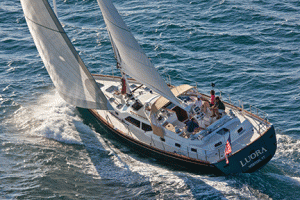 TARTAN 5300 •
TARTAN 5300 •  With the reacher drawing nicely, Luora was able to sail at about half the speed of the wind or 4 knots in 8 knots of breeze. This is not bad for a large moderate displacement cruising boat.That morning, on the website sailflow.com, the forecast had been for the sea breeze to come up at 2p.m. Lo and behold, at 2:10, the 6 to 8 knots of breeze was suddenly 10 and then 12. We trimmed for reaching speed along our eastward course and the 5300 really began to move. In 12 knots, we were easily making 6.5 through the water. Nice.While the breeze held, we rolled in the reacher and rolled out the jib so we could see how she handled upwind. The 5300 settled in at 45 degrees from the true wind and tacked effortlessly through 90 degrees.Finally, the breeze died, so we rolled up the headsail and cranked up the engine. Under power on a flat sea, the 5300 cruised easily at 8 knots and was capable of powering at more than 9 knots if asked. The 5300 is a big boat that feels nimble underfoot and slippery through the water.The hull has a narrow entry that enhances upwind performance and broad after sections that provide a lot of interior volume and will make the boat stiff and powerful when reaching. With the Cruise Control Rig, the 5300 is a cinch for a couple to handle from the cockpit.TARTAN AT 50This year, Tartan celebrates the 50th anniversary of the company’s founding. The first Tartan 27 rolled off the production line in 1961, so next year will also be a 50th anniversary. Five decades of continuous sailboat production is no small feat in America, so the company and its core of boat builders is to be congratulated.2010 marks another milestone for Tartan and C&C, too. On July 30th, Steve Malbasa and his wife Stephanie purchased the company from the previous owner and immediately set out to position it for a successful future. Tim Jackett, who is the company’s president and chief designer, is also a partner in the new business and will stay on to run the day-to-day operations.
With the reacher drawing nicely, Luora was able to sail at about half the speed of the wind or 4 knots in 8 knots of breeze. This is not bad for a large moderate displacement cruising boat.That morning, on the website sailflow.com, the forecast had been for the sea breeze to come up at 2p.m. Lo and behold, at 2:10, the 6 to 8 knots of breeze was suddenly 10 and then 12. We trimmed for reaching speed along our eastward course and the 5300 really began to move. In 12 knots, we were easily making 6.5 through the water. Nice.While the breeze held, we rolled in the reacher and rolled out the jib so we could see how she handled upwind. The 5300 settled in at 45 degrees from the true wind and tacked effortlessly through 90 degrees.Finally, the breeze died, so we rolled up the headsail and cranked up the engine. Under power on a flat sea, the 5300 cruised easily at 8 knots and was capable of powering at more than 9 knots if asked. The 5300 is a big boat that feels nimble underfoot and slippery through the water.The hull has a narrow entry that enhances upwind performance and broad after sections that provide a lot of interior volume and will make the boat stiff and powerful when reaching. With the Cruise Control Rig, the 5300 is a cinch for a couple to handle from the cockpit.TARTAN AT 50This year, Tartan celebrates the 50th anniversary of the company’s founding. The first Tartan 27 rolled off the production line in 1961, so next year will also be a 50th anniversary. Five decades of continuous sailboat production is no small feat in America, so the company and its core of boat builders is to be congratulated.2010 marks another milestone for Tartan and C&C, too. On July 30th, Steve Malbasa and his wife Stephanie purchased the company from the previous owner and immediately set out to position it for a successful future. Tim Jackett, who is the company’s president and chief designer, is also a partner in the new business and will stay on to run the day-to-day operations. In early August, I was able to spend a day in Ohio with Steve, Stephanie and Tim at their new factory in Painesville and out on the water sailing the Malbasas’ 4300. The plant is a huge step forward for the company. It is large, modern, clean and set up for highly efficient semi-custom boat building. As Tim noted, the move has allowed the company to shed some of its old habits and practices and given every individual in the company the chance to rethink and improve the way they do their jobs.This change in company culture is already having a positive effect throughout the industry as Tim and Steve set out to build the dealer network and expand the brands’ visibility in key sailing regions around the country. The Tartan and C&C brands are two of the most venerable in the country.In addition, the company owns Legacy Yachts, which has a line of premium motor yachts and cruisers, and Novis Composites, the in-house builder of carbon fiber spars, booms, poles and other parts for the boats.After a tour of the new factory with Tim and a visit to the old facility, which is in the process of a major face lift and where the hulls, decks and spars will be built, we met up with Steve and Stephanie aboard their 4300 for a late afternoon sail on Lake Erie. It was a lovely, warm day, so we hoisted the main, rolled out the reacher and flew out into the lake at 8 knots.
In early August, I was able to spend a day in Ohio with Steve, Stephanie and Tim at their new factory in Painesville and out on the water sailing the Malbasas’ 4300. The plant is a huge step forward for the company. It is large, modern, clean and set up for highly efficient semi-custom boat building. As Tim noted, the move has allowed the company to shed some of its old habits and practices and given every individual in the company the chance to rethink and improve the way they do their jobs.This change in company culture is already having a positive effect throughout the industry as Tim and Steve set out to build the dealer network and expand the brands’ visibility in key sailing regions around the country. The Tartan and C&C brands are two of the most venerable in the country.In addition, the company owns Legacy Yachts, which has a line of premium motor yachts and cruisers, and Novis Composites, the in-house builder of carbon fiber spars, booms, poles and other parts for the boats.After a tour of the new factory with Tim and a visit to the old facility, which is in the process of a major face lift and where the hulls, decks and spars will be built, we met up with Steve and Stephanie aboard their 4300 for a late afternoon sail on Lake Erie. It was a lovely, warm day, so we hoisted the main, rolled out the reacher and flew out into the lake at 8 knots. Steve Malbasa is a retired sales management executive who discovered sailing later in life and has jumped right into the deep end with enormous enthusiasm. He brings a very clear vision to the company that focuses entirely on making the “customer experience” the very best it can be, and better every day. This is a sound formula for success and promises to drive the company forward for another 50 years.THE DIFFERENCEOver the years, Tim Jackett has consistently innovated the design, engineering and construction of Tartan and C&C boats. They are one of only a few companies that provides carbon fiber masts, booms and poles as standard equipment; the “pocket boom” is also a unique solution to handling large, fully battened mainsails. The Cruise Control Rig takes a sail handling system often found on large custom yachts—particularly in Europe—and adapts it to couples’ cruising boats. It makes a huge amount of sense.The hulls and decks of all of the boats are infused, foam-cored, epoxy and e-glass laminations that have superior strength-to-weight ratios and extremely high glass-to-resin ratios. Epoxy is more expensive than vinylester or polyester resin but provides a structure that is completely inert and impervious to osmotic blistering. The idea is to build boats that will last generations, like the old Tartan 27 now owned by my nephew.
Steve Malbasa is a retired sales management executive who discovered sailing later in life and has jumped right into the deep end with enormous enthusiasm. He brings a very clear vision to the company that focuses entirely on making the “customer experience” the very best it can be, and better every day. This is a sound formula for success and promises to drive the company forward for another 50 years.THE DIFFERENCEOver the years, Tim Jackett has consistently innovated the design, engineering and construction of Tartan and C&C boats. They are one of only a few companies that provides carbon fiber masts, booms and poles as standard equipment; the “pocket boom” is also a unique solution to handling large, fully battened mainsails. The Cruise Control Rig takes a sail handling system often found on large custom yachts—particularly in Europe—and adapts it to couples’ cruising boats. It makes a huge amount of sense.The hulls and decks of all of the boats are infused, foam-cored, epoxy and e-glass laminations that have superior strength-to-weight ratios and extremely high glass-to-resin ratios. Epoxy is more expensive than vinylester or polyester resin but provides a structure that is completely inert and impervious to osmotic blistering. The idea is to build boats that will last generations, like the old Tartan 27 now owned by my nephew. These days, Tartans are less pure production boats than they are semi-custom yachts for owners who expect to tailor the interiors spaces a bit to their needs. This is particularly true in the larger boats such as the 5300. The boats are not built on a production line; instead, each is hand crafted by a team that is responsible for the fit out from the bare hull and deck through launching. This personal involvement shows in the final product.THE 5300 DOWN BELOWJeff and Linda Lennox stepped up to the plate to build hull number one of the 5300 design and, as noted above, brought a wealth of experience and ideas with them. Luora is very much their boat. The original plans for the 5300 show a raised saloon with the engine room, tanks and batteries under the saloon floor, where they are near the boat’s center of gravity. The saloon plans show two curved settees with the port side doubling as the dining table.The Lennoxes opted for a different plan in which the dinette remains to port but the starboard side of the saloon has a raised inside helm with a forward facing bench seat to starboard; this allows you to sail or pilot the boat from inside the saloon with good visibility all around and all of your navigation instruments right in front of you. Just aft of this is a desk and seat, and aft of that is what Tim calls the “Great Chair.” Part of this custom interior was to maintain access from the saloon to the after head on the starboard side so it can be used as the “day head” and will double as a wet locker for foul weather gear.
These days, Tartans are less pure production boats than they are semi-custom yachts for owners who expect to tailor the interiors spaces a bit to their needs. This is particularly true in the larger boats such as the 5300. The boats are not built on a production line; instead, each is hand crafted by a team that is responsible for the fit out from the bare hull and deck through launching. This personal involvement shows in the final product.THE 5300 DOWN BELOWJeff and Linda Lennox stepped up to the plate to build hull number one of the 5300 design and, as noted above, brought a wealth of experience and ideas with them. Luora is very much their boat. The original plans for the 5300 show a raised saloon with the engine room, tanks and batteries under the saloon floor, where they are near the boat’s center of gravity. The saloon plans show two curved settees with the port side doubling as the dining table.The Lennoxes opted for a different plan in which the dinette remains to port but the starboard side of the saloon has a raised inside helm with a forward facing bench seat to starboard; this allows you to sail or pilot the boat from inside the saloon with good visibility all around and all of your navigation instruments right in front of you. Just aft of this is a desk and seat, and aft of that is what Tim calls the “Great Chair.” Part of this custom interior was to maintain access from the saloon to the after head on the starboard side so it can be used as the “day head” and will double as a wet locker for foul weather gear. The rest of Luora is more or less the standard interior design. All the way forward, there is a large guest cabin with a centerline double berth and plenty of hanging and locker space for a couple who will be staying aboard for a while. Just aft to port is a double cabin with upper and lower berths. This will be a great kids’ cabin and will be comfortable at sea. The forward head, equipped with a full shower stall, is across from the double cabin. The truly huge master cabin all the way aft stretches the boat’s full beam. The centerline double is a full queen size—rare on a cruising boat. The cabin has two large hanging lockers and seats on both sides of the berth. The master head on the starboard side is huge and has a large shower stall.An alternative to the giant aft cabin is to move the head aft, thus reducing the width of the cabin. In the head’s place you can have a fourth cabin with upper and lower berths. This fourth cabin will be a wonderful place to sleep at sea and a good cabin for crew on long passages.The 5300’s galley lies in the passageway on the port side from the saloon to the aft cabin. The stove, storage lockers and fridges are outboard, while the double sinks are inboard and nearly on the centerline, where they will drain nicely on both tacks.Tartan has been using cherry in their interiors for several years. The bulkheads are cherry veneers over marine plywood while the drawers, doors and cabin faces are solid cherry. The woodwork is finished with a flat varnish that looks elegant.The 5300 feels like a bigger boat down below. The cabins are all large and well appointed, the heads are spacious, and the working spaces at the nav table, galley or inside steering station are all supplied with ample table or counter space.The boat is bright throughout and provided with excellent cross-ventilation through portholes and opening hatches. One could easily move aboard, as the Lennox family does, for extended periods of cruising in real comfort and style.BWS THOUGHTSThe 50th anniversary of the Tartan brand is reason enough to celebrate. The company is an American treasure. Now starting its second half-century under the new ownership of Steve and Stephanie Malbasa and Tim Jacket, there is reason to believe that the company will grow and prosper.The 5300 is the perfect flagship for the brand. It is a true family cruising boat in the Tartan tradition that incorporates many well thought out innovations and heirloom quality construction. As the year progresses, you will find new dealers in sailing centers around the country handling the line and a new optimism among Tartan owners that their boats will indeed be around for generations ahead.Tartan 5300LOA 53’0”LWL 46’6”Beam 16’2”Draft (keel) 6’8”Draft (K/CB) 5’6”/9’6”Displ. (K) 37,225 lbs.Displ. (K/CB) 38,225 lbs.Ballast (K) 13,000 lbs.Ballast (K/CB) 14,000 lbs.Fuel 125 gals.Water 250 gals.Sail Area 1,387 sq. ft.Mast height 80’0”Ballast/Displ. 35Displ./LWL 165Sail area/Displ. 20Tartan and C&C Yachts/Hanover MarinePainesville, OH 44077Ph: 440-392-2628Website: www.tartanyachts.com
The rest of Luora is more or less the standard interior design. All the way forward, there is a large guest cabin with a centerline double berth and plenty of hanging and locker space for a couple who will be staying aboard for a while. Just aft to port is a double cabin with upper and lower berths. This will be a great kids’ cabin and will be comfortable at sea. The forward head, equipped with a full shower stall, is across from the double cabin. The truly huge master cabin all the way aft stretches the boat’s full beam. The centerline double is a full queen size—rare on a cruising boat. The cabin has two large hanging lockers and seats on both sides of the berth. The master head on the starboard side is huge and has a large shower stall.An alternative to the giant aft cabin is to move the head aft, thus reducing the width of the cabin. In the head’s place you can have a fourth cabin with upper and lower berths. This fourth cabin will be a wonderful place to sleep at sea and a good cabin for crew on long passages.The 5300’s galley lies in the passageway on the port side from the saloon to the aft cabin. The stove, storage lockers and fridges are outboard, while the double sinks are inboard and nearly on the centerline, where they will drain nicely on both tacks.Tartan has been using cherry in their interiors for several years. The bulkheads are cherry veneers over marine plywood while the drawers, doors and cabin faces are solid cherry. The woodwork is finished with a flat varnish that looks elegant.The 5300 feels like a bigger boat down below. The cabins are all large and well appointed, the heads are spacious, and the working spaces at the nav table, galley or inside steering station are all supplied with ample table or counter space.The boat is bright throughout and provided with excellent cross-ventilation through portholes and opening hatches. One could easily move aboard, as the Lennox family does, for extended periods of cruising in real comfort and style.BWS THOUGHTSThe 50th anniversary of the Tartan brand is reason enough to celebrate. The company is an American treasure. Now starting its second half-century under the new ownership of Steve and Stephanie Malbasa and Tim Jacket, there is reason to believe that the company will grow and prosper.The 5300 is the perfect flagship for the brand. It is a true family cruising boat in the Tartan tradition that incorporates many well thought out innovations and heirloom quality construction. As the year progresses, you will find new dealers in sailing centers around the country handling the line and a new optimism among Tartan owners that their boats will indeed be around for generations ahead.Tartan 5300LOA 53’0”LWL 46’6”Beam 16’2”Draft (keel) 6’8”Draft (K/CB) 5’6”/9’6”Displ. (K) 37,225 lbs.Displ. (K/CB) 38,225 lbs.Ballast (K) 13,000 lbs.Ballast (K/CB) 14,000 lbs.Fuel 125 gals.Water 250 gals.Sail Area 1,387 sq. ft.Mast height 80’0”Ballast/Displ. 35Displ./LWL 165Sail area/Displ. 20Tartan and C&C Yachts/Hanover MarinePainesville, OH 44077Ph: 440-392-2628Website: www.tartanyachts.com 2011 BOAT SHOW PREVIEW • BAVARIA CRUISER 32 • Last summer, Bavaria USA introduced four new models to the U.S. market. The smallest of the fleet is the Bavaria 32, which packs a lot in a fairly small package. Designed by Farr Yacht Design, who designed all of the new Bavaria models, the 32 has a voluminous hull that makes the interior feel like you are on a 36-footer. But the boat is also very slippery through the water and extremely close-winded for a cruising boat.
2011 BOAT SHOW PREVIEW • BAVARIA CRUISER 32 • Last summer, Bavaria USA introduced four new models to the U.S. market. The smallest of the fleet is the Bavaria 32, which packs a lot in a fairly small package. Designed by Farr Yacht Design, who designed all of the new Bavaria models, the 32 has a voluminous hull that makes the interior feel like you are on a 36-footer. But the boat is also very slippery through the water and extremely close-winded for a cruising boat. BAVARIA CRUISER 36 • Like its little sister, the Bavaria Cruiser 36 feels much larger than its length might imply. In fact, this boat feels bigger when stepped aboard, when it is hit by a puff of wind, and when you go below into the cabin.
BAVARIA CRUISER 36 • Like its little sister, the Bavaria Cruiser 36 feels much larger than its length might imply. In fact, this boat feels bigger when stepped aboard, when it is hit by a puff of wind, and when you go below into the cabin. The BAVARIA CRUISER 40 takes the company’s theme of large interiors in boats that sail very well and really puts it to great use. The 40 comes with only one accommodation plan—a three-cabin, two-head layout that emphasizes comfort.
The BAVARIA CRUISER 40 takes the company’s theme of large interiors in boats that sail very well and really puts it to great use. The 40 comes with only one accommodation plan—a three-cabin, two-head layout that emphasizes comfort. Bavaria builds three larger Cruisers—the 45, 50 and 55—but of these, only the CRUISER 45 will be in the U.S. this year.
Bavaria builds three larger Cruisers—the 45, 50 and 55—but of these, only the CRUISER 45 will be in the U.S. this year. BENETEAU OCEANIS 41 & 45 • This fall, Beneteau will unveil two new Oceanis models that carry on the Oceanis cruising traditions while incorporating some truly innovative design features to make the boats easier to sail and more comfortable to live aboard. The most notable feature in the new design is the high cockpit arch that anchors the main sheet and provides a rigid frame for a dodger and other cockpit enclosures. Both boats are truly set up for indoor-outdoor living, so the cockpits are huge and access up and down the companionway ladder is excellent.
BENETEAU OCEANIS 41 & 45 • This fall, Beneteau will unveil two new Oceanis models that carry on the Oceanis cruising traditions while incorporating some truly innovative design features to make the boats easier to sail and more comfortable to live aboard. The most notable feature in the new design is the high cockpit arch that anchors the main sheet and provides a rigid frame for a dodger and other cockpit enclosures. Both boats are truly set up for indoor-outdoor living, so the cockpits are huge and access up and down the companionway ladder is excellent. The Oceanis 45 is also offered with three optional accommodation plans. The two-cabin, two-head version has the same large storage area aft as seen in the 41. The three-cabin, two-head plan replaces the storage area aft with a second aft cabin. And, the three-cabin, three-head design equips each of the three cabins with its own en suite head; in this version, the shower stall in the aft head has been replaced with an expanded dinette storage compartment. Both of the new boats are being built in Beneteau’s plant in Marion, South Carolina, so they are truly American boats.
The Oceanis 45 is also offered with three optional accommodation plans. The two-cabin, two-head version has the same large storage area aft as seen in the 41. The three-cabin, two-head plan replaces the storage area aft with a second aft cabin. And, the three-cabin, three-head design equips each of the three cabins with its own en suite head; in this version, the shower stall in the aft head has been replaced with an expanded dinette storage compartment. Both of the new boats are being built in Beneteau’s plant in Marion, South Carolina, so they are truly American boats. HAKE SEAWARD 46 • An innovative design from Hake Yachts in Florida, the new Seaward 46 is a shoal draft cruiser that is capable of extended offshore sailing. With a ballasted retractable keel and retractable rudders, the 46 can cruise in less than three feet of water. Yet, with the keel and rudders fully deployed, the boat will draw over seven feet and will be a stiff and stable platform for blue water sailing.
HAKE SEAWARD 46 • An innovative design from Hake Yachts in Florida, the new Seaward 46 is a shoal draft cruiser that is capable of extended offshore sailing. With a ballasted retractable keel and retractable rudders, the 46 can cruise in less than three feet of water. Yet, with the keel and rudders fully deployed, the boat will draw over seven feet and will be a stiff and stable platform for blue water sailing. HALLBERG-RASSY 372 • The new German Frers-designed Hallberg Rassy 372 is another cruiser under 40-feet that will appeal to couples and young families. The 372 replaces the popular HR 37.
HALLBERG-RASSY 372 • The new German Frers-designed Hallberg Rassy 372 is another cruiser under 40-feet that will appeal to couples and young families. The 372 replaces the popular HR 37. HANSE 495 • This year, Hanse will introduce several new models, among them the stylish and innovative 495. A powerful modern cruising sloop, the 495 has a Judel-Vrolijk hull with a nearly plumb bow and squared-off transom. The hull’s sheer is fairly straight, so the boat’s profile makes it look purposeful and fast. Think of that long waterline.
HANSE 495 • This year, Hanse will introduce several new models, among them the stylish and innovative 495. A powerful modern cruising sloop, the 495 has a Judel-Vrolijk hull with a nearly plumb bow and squared-off transom. The hull’s sheer is fairly straight, so the boat’s profile makes it look purposeful and fast. Think of that long waterline. MOODY 45AC • Hanse Yachts in Germany bought the Moody brand several years ago and came out at once with a truly innovative deck saloon or pilothouse model that turned a lot of heads. Since then, the company has gone back to designer Bill Dixon for a more traditional aft cockpit luxury cruising boat to fit the Moody brand.
MOODY 45AC • Hanse Yachts in Germany bought the Moody brand several years ago and came out at once with a truly innovative deck saloon or pilothouse model that turned a lot of heads. Since then, the company has gone back to designer Bill Dixon for a more traditional aft cockpit luxury cruising boat to fit the Moody brand. ISLAND PACKET 360 • Island Packet Yachts has been building seaworthy cruising boats for 30 years, and you will find them in the world’s best cruising grounds. With designer Bob Johnson’s Full Foil Keel, moderate sail area-to-displacement ratios, cutter rigs and self-tacking Hoyt Jib Boom Staysails, the line has a well earned reputation for easy motion in a seaway and high average speeds over the long haul. On IPY designs, you arrive at the end of the passage more rested than when you began.
ISLAND PACKET 360 • Island Packet Yachts has been building seaworthy cruising boats for 30 years, and you will find them in the world’s best cruising grounds. With designer Bob Johnson’s Full Foil Keel, moderate sail area-to-displacement ratios, cutter rigs and self-tacking Hoyt Jib Boom Staysails, the line has a well earned reputation for easy motion in a seaway and high average speeds over the long haul. On IPY designs, you arrive at the end of the passage more rested than when you began. HUNTER e33 • Hunter has long been a leader in offering sailors a wide range of boats, from sailing dinghies to 50-foot ocean cruisers. But the company may be best known for its mid-size cruisers, which offer expansive living spaces in boats that are easy to sail and handle.
HUNTER e33 • Hunter has long been a leader in offering sailors a wide range of boats, from sailing dinghies to 50-foot ocean cruisers. But the company may be best known for its mid-size cruisers, which offer expansive living spaces in boats that are easy to sail and handle. JEANNEAU 379 • The success of the Jeanneau Sun Odyssey 409 that was introduced at last year’s Annapolis show, with its hard chine aft, fold-down stern platform and simple but powerful sloop rig, primed the market for more Jeanneaus of the same style. So this year, Jeanneau is launching the Sun Odyssey 379 and Sun Odyssey 439.
JEANNEAU 379 • The success of the Jeanneau Sun Odyssey 409 that was introduced at last year’s Annapolis show, with its hard chine aft, fold-down stern platform and simple but powerful sloop rig, primed the market for more Jeanneaus of the same style. So this year, Jeanneau is launching the Sun Odyssey 379 and Sun Odyssey 439. The new JEANNEAU 439 has a larger, beamier Philippe Briand hull that will translate into greater cabin volume and stability. The bow sections have a bit more hollow for a narrow entry, which will improve the boat’s motion and windward ability.
The new JEANNEAU 439 has a larger, beamier Philippe Briand hull that will translate into greater cabin volume and stability. The bow sections have a bit more hollow for a narrow entry, which will improve the boat’s motion and windward ability. The 44 DECK SALOON (DS) Sun Odysseys are all about elegance, style and comfort. From the swim platform aft to the bow rollers forward, the 44DS embodies the latest in Euro styling. The Philippe Briand designed hull is similar to the 439, but there the similarity ends.
The 44 DECK SALOON (DS) Sun Odysseys are all about elegance, style and comfort. From the swim platform aft to the bow rollers forward, the 44DS embodies the latest in Euro styling. The Philippe Briand designed hull is similar to the 439, but there the similarity ends. The new OYSTER 625, which has been nominated for 2012 Boat of the Year in Europe, is a Rob Humphries design that dramatically upgrades the already popular previous boats in the Oyster line, the 61 and 62.
The new OYSTER 625, which has been nominated for 2012 Boat of the Year in Europe, is a Rob Humphries design that dramatically upgrades the already popular previous boats in the Oyster line, the 61 and 62. The SABRE 456 was launched late last year and has drawn a lot of attention from both Sabre owners and would-be Sabre owners.
The SABRE 456 was launched late last year and has drawn a lot of attention from both Sabre owners and would-be Sabre owners. The new Tim Jackett-designed TARTAN 4000, which was introduced last winter, embodies a lot of the new thinking that has gone into the boats and the company since it was purchased by Steve Malbasa last year. The new company is all about delighting customers with great boats and great service.
The new Tim Jackett-designed TARTAN 4000, which was introduced last winter, embodies a lot of the new thinking that has gone into the boats and the company since it was purchased by Steve Malbasa last year. The new company is all about delighting customers with great boats and great service. A semi-custom design that was spawned last year and launched late last spring, the new TARTAN 4700 expands upon themes introduced in the 4400 a few years ago.
A semi-custom design that was spawned last year and launched late last spring, the new TARTAN 4700 expands upon themes introduced in the 4400 a few years ago. Tartan 4700 • For 50 years, Tartan has been building high quality production cruising and performance cruising boats in the suburbs of Cleveland, Ohio that have set a worldwide standard for integrity and design quality. But until this year, the company was never known as a custom or semi-custom builder. Out of their innovative efforts, a new model has been introduced into the Tartan family of cruisers.
Tartan 4700 • For 50 years, Tartan has been building high quality production cruising and performance cruising boats in the suburbs of Cleveland, Ohio that have set a worldwide standard for integrity and design quality. But until this year, the company was never known as a custom or semi-custom builder. Out of their innovative efforts, a new model has been introduced into the Tartan family of cruisers.
 The galley on the 4700 is very similar to that on the 4400, which is to say that it is an amazing seagoing galley for a boat of this size. The top-loading fridge and freezer are under the main counter. The four-burner stove is outboard. The twin sinks are nearly on the centerline, where they will drain well on both tacks. Under the sinks, you have access to the fresh water manifolds and other systems that need to be handy.
The galley on the 4700 is very similar to that on the 4400, which is to say that it is an amazing seagoing galley for a boat of this size. The top-loading fridge and freezer are under the main counter. The four-burner stove is outboard. The twin sinks are nearly on the centerline, where they will drain well on both tacks. Under the sinks, you have access to the fresh water manifolds and other systems that need to be handy. The 4700’s rig, like all of the rigs in the Tartan line, comes standard with a carbon fiber mast and unique carbon fiber pocket boom; the use of carbon fiber reduces weight aloft significantly, thus reducing the boat’s tendency to pitch and roll. Plus, lighter weight adds to sailing performance. The Leisure Furl boom on Glory was added as a labor saving option.
The 4700’s rig, like all of the rigs in the Tartan line, comes standard with a carbon fiber mast and unique carbon fiber pocket boom; the use of carbon fiber reduces weight aloft significantly, thus reducing the boat’s tendency to pitch and roll. Plus, lighter weight adds to sailing performance. The Leisure Furl boom on Glory was added as a labor saving option. No doubt, the 4700, with its extra tall rig, will offer even better performance. And, with a longer waterline it will be less liable to pitch in a seaway. The 4700’s transom looks right on the boat and adds just enough to the lines to really enhance the hull’s overall look. Plus, the extra length adds to the spaciousness of the cockpit and after swim platform. The
No doubt, the 4700, with its extra tall rig, will offer even better performance. And, with a longer waterline it will be less liable to pitch in a seaway. The 4700’s transom looks right on the boat and adds just enough to the lines to really enhance the hull’s overall look. Plus, the extra length adds to the spaciousness of the cockpit and after swim platform. The 2012 BOAT SHOW PREVIEW: MONOHULLS • This fall and winter across the country, boat builders will be rolling out their latest models at national and regional boat shows. Once again, Blue Water Sailing is happy to bring you a preview of the monohulls that will grace the shows. Check out the new fleet of multihulls in the August edition of Multihulls Quarterly.
2012 BOAT SHOW PREVIEW: MONOHULLS • This fall and winter across the country, boat builders will be rolling out their latest models at national and regional boat shows. Once again, Blue Water Sailing is happy to bring you a preview of the monohulls that will grace the shows. Check out the new fleet of multihulls in the August edition of Multihulls Quarterly. BAVARIA
BAVARIA  The 50, similar to the rest of the Cruiser line, is a roomy, easy-to-sail performance cruiser that will appeal to families who need a lot of space or couples who will be living aboard for long periods. BWS sailed the twin-wheel, twin-rudder 50 last year in Turkey and found it to be a remarkably good sailboat that is close-winded and slippery off the wind.
The 50, similar to the rest of the Cruiser line, is a roomy, easy-to-sail performance cruiser that will appeal to families who need a lot of space or couples who will be living aboard for long periods. BWS sailed the twin-wheel, twin-rudder 50 last year in Turkey and found it to be a remarkably good sailboat that is close-winded and slippery off the wind. BENETEAU
BENETEAU The new Sense 55 follows on the heels of the Sense 50 and 43. The boat has a definite “wow” factor, as it is a true indoor-outdoor cruiser that offers many of the benefits of a cruising catamaran combined with the convenience, elegance and practicality of a monohull. Like its little sisters, the 55 redefines the living spaces into the outdoor “patio,” the living room-like saloon and the private sleeping quarters forward. The living spaces flow together smoothly, and huge windows and opening ports enhance ventilation, brightness below and communication between crew. The new boat has highly lacquered cabinet surfaces, finely finished built-in furniture, and a clean and elegant look on deck and below. See our full review in the August 2012 edition of BWS.
The new Sense 55 follows on the heels of the Sense 50 and 43. The boat has a definite “wow” factor, as it is a true indoor-outdoor cruiser that offers many of the benefits of a cruising catamaran combined with the convenience, elegance and practicality of a monohull. Like its little sisters, the 55 redefines the living spaces into the outdoor “patio,” the living room-like saloon and the private sleeping quarters forward. The living spaces flow together smoothly, and huge windows and opening ports enhance ventilation, brightness below and communication between crew. The new boat has highly lacquered cabinet surfaces, finely finished built-in furniture, and a clean and elegant look on deck and below. See our full review in the August 2012 edition of BWS.  CATALINA
CATALINA COM-PAC
COM-PAC  DUFOUR
DUFOUR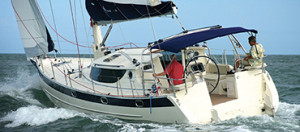 HAKE SEAWARD 46
HAKE SEAWARD 46 HANSE
HANSE JEANNEAU
JEANNEAU MOODY
MOODY MORRIS
MORRIS TARTAN and C&C
TARTAN and C&C Tartan Fantail 26 • The new daysailer-weekender from Tartan Yachts packs a lot of performance in a compact package.
Tartan Fantail 26 • The new daysailer-weekender from Tartan Yachts packs a lot of performance in a compact package.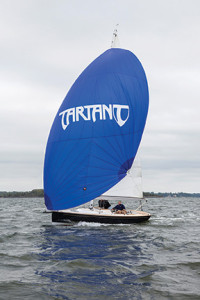 Technically, the Torqeedo is a very interesting propulsion system for a small sailboat. The throttle and gear shifter is linked to a GPS and has a small LED readout that gives you course, speed and remaining powering range. The electric motor is powered by two 4D AGM batteries and a third Group 27 battery is used to power onboard systems such as running lights, reading lights and electronics. With a full charge, the motor will drive the boat at half speed or about 4 knots for 16 hours before the batteries need to be charged again. Tartan provides a shore-power battery charging system and, for those who will keep their boats on moorings, they offer wind and solar charging systems as options.
Technically, the Torqeedo is a very interesting propulsion system for a small sailboat. The throttle and gear shifter is linked to a GPS and has a small LED readout that gives you course, speed and remaining powering range. The electric motor is powered by two 4D AGM batteries and a third Group 27 battery is used to power onboard systems such as running lights, reading lights and electronics. With a full charge, the motor will drive the boat at half speed or about 4 knots for 16 hours before the batteries need to be charged again. Tartan provides a shore-power battery charging system and, for those who will keep their boats on moorings, they offer wind and solar charging systems as options.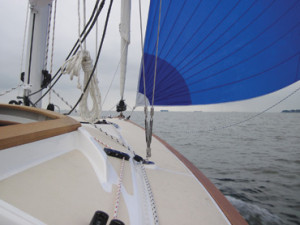 THE DESIGN
THE DESIGN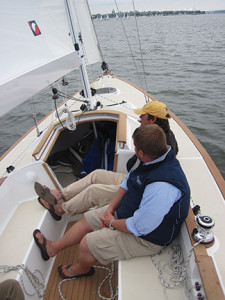 The cockpit is nine feet long, so four adults can fit comfortably and still manage the sheets and control lines without getting in each other’s way. The self-tacking jib certainly reduces sheet clutter in the cockpit. The main sheet is all the way aft, where it is handy to the helm.
The cockpit is nine feet long, so four adults can fit comfortably and still manage the sheets and control lines without getting in each other’s way. The self-tacking jib certainly reduces sheet clutter in the cockpit. The main sheet is all the way aft, where it is handy to the helm.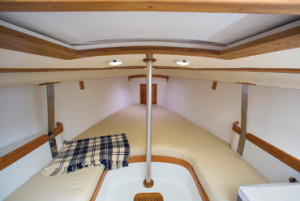 DOWN BELOW
DOWN BELOW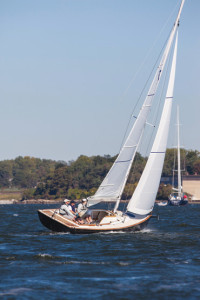 We have something of a soft spot for smaller Tartan designs since we grew up sailing a Tartan 27—parents and three large sons—all over New England as we cruised to PHRF regattas, raced over weekends and then sailed home again. The new Fantail updates the concept by a country mile. The Fantail 26 is less of a cruising boat than a fine daysailer and weekender, which suits today’s sailing styles. Yet, you could take the weekender off for a week at a time and have a very pleasant small boat cruising experience.
We have something of a soft spot for smaller Tartan designs since we grew up sailing a Tartan 27—parents and three large sons—all over New England as we cruised to PHRF regattas, raced over weekends and then sailed home again. The new Fantail updates the concept by a country mile. The Fantail 26 is less of a cruising boat than a fine daysailer and weekender, which suits today’s sailing styles. Yet, you could take the weekender off for a week at a time and have a very pleasant small boat cruising experience. 2013 Boat Show Preview • The fall and winter boat show season is on the horizon and with that comes excitement from not only boat builders, but boat buyers as well. As always, BWS is happy to give you a rundown on what to expect as you tour this year’s shows. For a preview of the newest multihulls, see the August 2013 issue of Multihulls Quarterly.
2013 Boat Show Preview • The fall and winter boat show season is on the horizon and with that comes excitement from not only boat builders, but boat buyers as well. As always, BWS is happy to give you a rundown on what to expect as you tour this year’s shows. For a preview of the newest multihulls, see the August 2013 issue of Multihulls Quarterly. BAVARIA
BAVARIA BENETEAU
BENETEAU BLUE JACKET 40
BLUE JACKET 40 C&C
C&C CATALINA
CATALINA DEHLER
DEHLER  DUFOUR
DUFOUR HANSE
HANSE ISLAND PACKET
ISLAND PACKET JEANNEAU
JEANNEAU J/BOATS
J/BOATS HUNTER
HUNTER  MORRIS YACHTS
MORRIS YACHTS  MOODY
MOODY  PASSPORT
PASSPORT  RUSTLER
RUSTLER  SEAWARD
SEAWARD  S&S 30
S&S 30  Tartan
Tartan 






